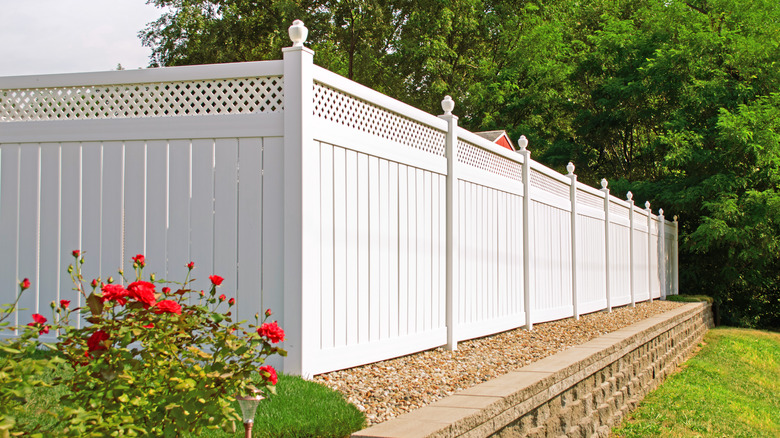Is It Possible To Change The Color Of My Vinyl Fence?
The best colors to paint your fence change over time. In the 70s, it was all mustard yellows and rusty oranges; today, soft greys and subtle greens are in. Given this, you're probably already tired of the color of that vinyl fence you installed a decade ago. That 2010s sage and sunflower yellow is starting to hurt your eyes and resale value. But is it even possible to transform the hue of vinyl pickets, rails, and trim? The short answer is yes. The long answer — the how — is more complicated, involving a lengthy preparation process and specialized paints. And beware: Painting your vinyl fence may void the manufacturer's warranty.
Vinyl fences are manufactured in your desired shade, meaning the planks can't be sanded back to an original, neutral color like you can with wood. The color is literally part of the material. This ensures the fence — and its original color — may last as long as 50 years with the proper care. Today, some HOAs even require homeowners to remove their wood fences and replace them with vinyl equivalents, possibly due to their reputation for looking good for a long time.
Gather your supplies
To change the color of your vinyl fence by painting it, you'll need some 220-grit sandpaper and a sanding block, soap or detergent, a hose or buckets, access to a water source, and a soft and stiff-bristled brush. If you have a power washer (or can get one), you can use that to clean your fence instead of washing it by hand. "Choose a spray tip that has a wider, cone-shaped spray and a lower PSI, around 300 or so," California painting experts PaintRite Pros suggest. You also need something to paint with, be it a paint-spraying system or rollers and brushes.
Paint-wise, look for an epoxy-based exterior paint that says it's designed for use on vinyl on the label. Oil or latex-based paints don't allow for the expansion and contraction vinyl fences undergo and will crack or peel. Try BEHR Premium Plus Exterior Flat, 1 gallon for $43.98 at Home Depot, or Valspar Duramax Tintable Exterior Paint and Primer, 5 gallons for $233.00 at Lowe's. Choose light hues, as dark shades attract the heat, potentially causing warping. And don't forget to measure your fence to ensure you buy enough pails to cover the fence twice or thrice over. You'll also need to buy a primer and a high-gloss sealant — again, designed for exterior use.
Get painting
Just as you'd clean your walls before painting them, you need to give your vinyl fence a once over with soap, water, and a brush, too. A mix of detergent and Dawn soap works well, as does a vinegar-water solution. Start with a hard-bristle brush to tackle the dirt embedded in the crevices, and move on to a softer bristled brush for the panels, working in a circular motion. Rinse the fence with fresh water. You can achieve the same result faster and arguably better with a power washer.
Sand the fence using sandpaper on tight spots and a sanding block for the rest. Rinse the dust off with water and use a vinyl repair kit to repair dings, like this popular Vinyl Fence Patch Kit in White at $42.99 from Fence Daddy. Priming is the next essential step. A primer adds more much-needed texture to vinyl's traditionally silky surface. Along with sanding, this helps the paint stick. Look for a primer with mold and mildew protection. Dutch Boy's Zero VOC Primer, 1 gallon for $28.46 at Menards, is a good option.
Once the primer is dry (about four hours), you can start painting. Whether using a paint roller and paintbrush or a sprayer, complete the corners, tops, and bottoms of the fence before painting the panels. Apply two to three coats, waiting for each coat to dry in between. Finish the fence with your high-gloss sealant to protect against fading, cracking, and bubbling.

